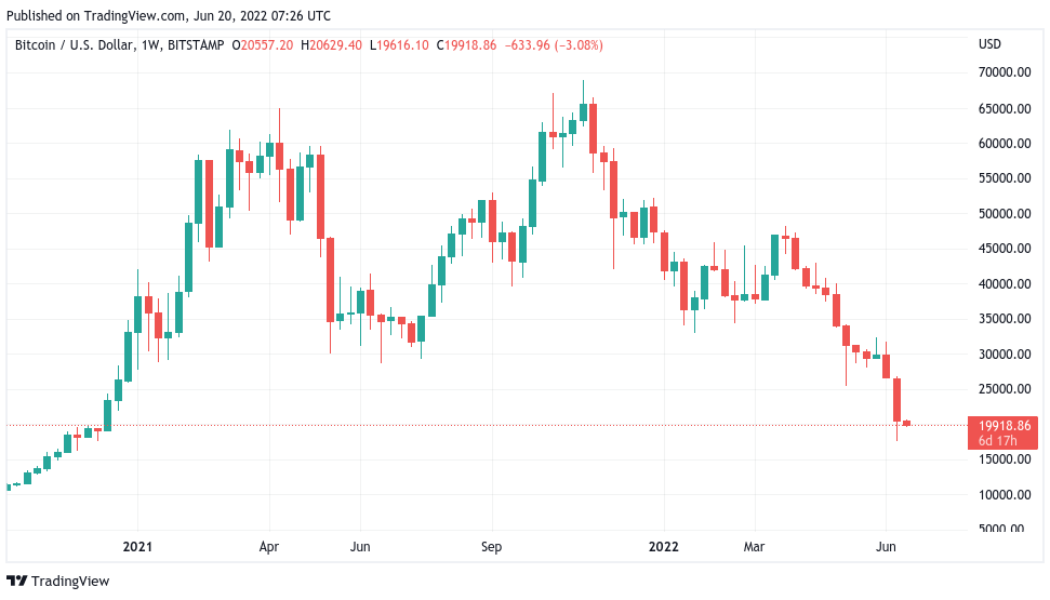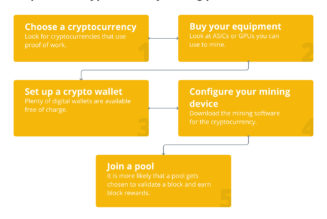Bitcoin (BTC) starts a new week still battling for $20,000 support as the market takes in a week of severe losses.
What felt all but impossible just weeks ago is now a reality as $20,000 — the all-time high from 2017 to 2020 — returns to give investors a grim sense of deja vu.
Bitcoin dipped as low as $17,600 over the weekend, and tensions are running high ahead of the June 20 Wall Street open.
While BTC price losses have statistically been here before — and even lower — concerns are mounting for network stability at current levels, with attention particularly focused on miners.
Add to that the consensus that macro markets have likely not bottomed, and it becomes understandable why sentiment around Bitcoin and crypto is at record low levels.
Cointelegraph takes a look at some major areas of interest for hodlers when it comes to Bitcoin price action in the coming days.
Bitcoin rescues $20,000 on weekly chart
At $20,580, Bitcoin’s latest weekly close could have been worse — the largest cryptocurrency managed to retain a key support level at least on weekly timeframes.
The wick below stretched $2,400, however, and a repeat performance could heighten the pain for those betting on $20,000, forming a significant price level.
Overnight, BTC/USD reached highs of $20,629 on Bitstamp before returning to consolidate immediately below the $20,000 mark, indicating that the situation remains precarious on lower timeframes.
Think prices should run up a lot now, punishing panic sellers and forced sellers. Recovering at least half the drop from two Fridays ago (CPI day). I want to see a fast reaction up from here next couple of days. The best rallies are those that don’t give laggards an entry.
— Alex Krüger (@krugermacro) June 19, 2022
While some call for a snap recovery, the overall mood among commentators remains one of more cautious optimism.
“Over the weekend, while the fiat rails are closed, $BTC dropped to a low of $17,600 down almost 20% from Friday on good volume. Smells like a forced seller triggered a run on stops,” Arthur Hayes, ex-CEO of derivatives trading platform BitMEX, argued in a Twitter thread on June 2.
Hayes postulated that the recovery came as soon as those forced sales ended, but more sell-side pressure may still come.
“Is it over yet … idk,” another post read:
“But for those skilled knife catchers, there may yet be additional opportunities to buy coin from those who must whack every bid no matter the price.”
The role of crypto hedge funds and related investment vehicles in exacerbating BTC price weakness has become a key topic of debate since the May Terra implosion. With Celsius, Three Arrows Capital and others now joining the chaos forced liquidations resulting from multi-year lows may be what is required to stabilize the market long term.
“Bitcoin is not done liquidating large players,” investor Mike Alfred argued on June 18:
“They will take it down to a level that will cause the maximum damage to the most overexposed players like Celsius and then suddenly it will bounce and go higher once those firms are completely obliterated. A story as old as time.”
Elsewhere, $16,000 is still a popular target, this in itself only equating to a 76% drawdown from Bitcoin’s November 2021 all-time highs. As Cointelegraph reported, estimates currently run as low as $11,000 — 84.5%.
“$31k-32k was broken and used as resistance. Same is happening with $20k-21k. Main target: $16k-17k, especially $16,000-16,250,” popular Twitter account Il Capo of Crypto summarized.
It additionally described $16,000 as a “strong magnet.”

Stocks and bonds have “nowhere to hide”
A limp outlook for equities prior to the Wall Street open, meanwhile, provides little by way of upside prospects for BTC on June 20.
As noted by analyst and commentator Josh Rager, the correlation between Bitcoin and stocks remains in full force.
Equity futures are down
Therefore $BTC follows https://t.co/pXih3MdbzZ
— Rager (@Rager) June 20, 2022
The stars seem to be aligning for shorters. Globally, stocks are lining up their “worst quarter ever,” according to data current as of June 18, with crypto markets giving investors a taste of reality months in advance.
Nowhere to hide: Stocks and bonds together are on track for their worst quarter ever. Meanwhile, credit markets have also taken a battering. #Bitcoin has lost over two-thirds of its value since it touched a high of nearly $70,000 in Nov. (via BBG) pic.twitter.com/CP3zmzhVTl
— Holger Zschaepitz (@Schuldensuehner) June 18, 2022
As such, it seems that the only market player able to turn the tide is the central bank, and notably the Federal Reserve.
Monetary tightening, some now claim, cannot last long, as its negative impact will force the Fed to start expanding the United States dollar supply once again. This, in turn, would see cash flow back into risk assets.
This is a perspective even shared by the Fed itself in the event that the U.S. encounters a recession — something with a high chance of happening, depending on the interpretation of recent Fed comments.
Referring to the accommodative environment with ultra-low rates, Fed governor Christopher J. Waller said in a speech June 18:
“I hope we never have another two years like 2020 and 2021, but because of the low-interest-rate environment we now face, I believe that even in a typical recession there is a decent chance that we will be considering policy decisions in the future similar to those we made over the past two years.”
In the meantime, however, policy dictates increased rate hikes, these being the direct trigger for increased risk-asset losses when announced by the Fed earlier in the month.
Miners in no mood for capitulation
Who is selling BTC at the lowest levels since November 2020?
On-chain data has been tracking the investor cohorts contributing to selling pressure — some forced, some voluntarily.
Miners, who may already be underwater when it comes to participating in finding blocks, have gone from buyers to sellers, halting a multi-year trend of accumulation.
“Miners have spent around 9k $BTC from their treasuries this week, and still hold around 50k $BTC,” on-chain analytics firm Glassnode confirmed on June 19.
Miner production cost, however, is difficult to calculate exactly, and different setups face drastically different mining conditions and expenses. As such, many may still be profitable even at current prices.
Bitcoin is not below electrical cost, especially large scale miners where marginal costs are closer to 10k than 20k. From @GalaxyDigitalHQ: pic.twitter.com/8iSvzZqCtT
— MAGS ⛏️ (@Crypto_Mags) June 18, 2022
Data from BTC.com, meanwhile, delivers surprising news. Bitcoin’s network difficulty is not about to drop to reflect a miner exodus. Instead, it is due to adjust upward this week.
Difficulty allows the Bitcoin network to adjust to changing economic conditions and is the backbone of its uniquely successful proof-of-work algorithm. If miners quit due to a lack of profitability, difficulty automatically decreases to lower costs and make mining more attractive.
So far, however, miners remain on board.
Likewise, hash rate, while coming off record highs, remains above an estimated 200 exahashes per second (EH/s). Hardware power dedicated to mining is thus at similar levels to before.

Seller or hodler, Bitcoiners see “massive” losses
Overall, however, both big and small hodlers who could not ride out the storm faced “massive” losses when they sold, Glassnode says.
“If we assess the damage, we can see that almost all wallet cohorts, from Shrimp to Whales, now hold massive unrealized losses, worse than March 2020,” researchers noted alongside a chart showing just how far BTC holdings had fallen versus cost basis:
“The least profitable wallet cohort hold 1-100 $BTC, and have unrealized losses equal to 30% of the Market Cap.”

The figures point to a state of panic among even seasoned investors, arguably a surprising phenomenon given Bitcoin’s history of volatility.
A look at the HODL Waves indicator, which groups coins by how long ago they last moved, meanwhile captures on record those selling and those buying the dip.
Between June 13 and June 19, the percentage of the overall BTC supply that last moved between a day and a week prior rose from 1.65% to nearly 6%.

Sentiment almost hits historic lows
It was already “comparable to a funeral” in December 2021, but crypto market sentiment has outdone itself.
Related: Top 5 cryptocurrencies to watch this week: BTC, SOL, LTC, LINK, BSV
According to monitoring resource the Crypto Fear & Greed Index, the average investor is now more fearful than at almost any time in the history of the industry.
On June 19, the Index, which uses a basket of factors to calculate overall sentiment, fell to near record lows of just 6/100 — deep within its “extreme fear” category.
The weekly close only marginally improved the situation, with the Index adding three points to still linger at levels that have historically marked bear market lows for Bitcoin.
Only in August 2019 did Fear & Greed clock a lower score.

The views and opinions expressed here are solely those of the author and do not necessarily reflect the views of Cointelegraph.com. Every investment and trading move involves risk, you should conduct your own research when making a decision.
 [flexi-common-toolbar] [flexi-form class=”flexi_form_style” title=”Submit to Flexi” name=”my_form” ajax=”true”][flexi-form-tag type=”post_title” class=”fl-input” title=”Title” value=”” required=”true”][flexi-form-tag type=”category” title=”Select category”][flexi-form-tag type=”tag” title=”Insert tag”][flexi-form-tag type=”article” class=”fl-textarea” title=”Description” ][flexi-form-tag type=”file” title=”Select file” required=”true”][flexi-form-tag type=”submit” name=”submit” value=”Submit Now”] [/flexi-form]
[flexi-common-toolbar] [flexi-form class=”flexi_form_style” title=”Submit to Flexi” name=”my_form” ajax=”true”][flexi-form-tag type=”post_title” class=”fl-input” title=”Title” value=”” required=”true”][flexi-form-tag type=”category” title=”Select category”][flexi-form-tag type=”tag” title=”Insert tag”][flexi-form-tag type=”article” class=”fl-textarea” title=”Description” ][flexi-form-tag type=”file” title=”Select file” required=”true”][flexi-form-tag type=”submit” name=”submit” value=”Submit Now”] [/flexi-form]









Tagged: Bitcoin, BTC price, crypto blog, Crypto news, Mining, Stocks